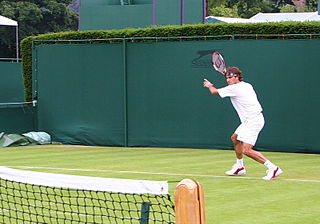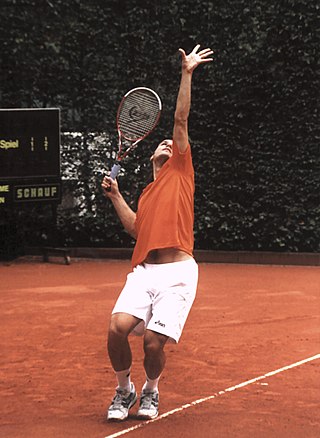
Tennis is a racket sport that is played either individually against a single opponent (singles) or between two teams of two players each (doubles). Each player uses a tennis racket that is strung with cord to strike a hollow rubber ball covered with felt over or around a net and into the opponent's court. The object of the game is to manoeuvre the ball in such a way that the opponent is not able to play a valid return. The player who is unable to return the ball validly will not gain a point, while the opposite player will.

Roger Federer is a Swiss former professional tennis player. He was ranked world No. 1 by the Association of Tennis Professionals (ATP) for 310 weeks, including a record 237 consecutive weeks, and finished as the year-end No. 1 five times. He won 103 singles titles on the ATP Tour, the second most of all time, including 20 major men's singles titles, a record eight men's singles Wimbledon titles, an Open Era joint-record five men's singles US Open titles, and a joint-record six year-end championships. In his home country, he is regarded as "the greatest and most successful" Swiss sportsperson in history.

A grass court is one of the four different types of tennis court on which the sport of tennis, originally known as "lawn tennis", is played. Grass courts are made of grasses in different compositions depending on the tournament.
Serve-and-volley is a style of play in tennis where the player serving moves quickly towards the net after hitting a serve, to attempt to hit a volley afterwards. In the serve-and-volley playstyle, the server attempts to hit a volley, as opposed to the baseline game, where the server stays back following the serve and attempts to hit a groundstroke. The serve-and-volley style of play has diminished in recent years with advances in racquet and string technologies which allow players to generate a great amount of top spin on groundstrokes and passing shots. The slowing of court surfaces and deflation of balls, promoting longer rallies for the enjoyment of spectators, has also devalued the serve-and-volley style.

The forehand in tennis and other racket sports such as table tennis, squash and badminton is a shot made by swinging the racket across one's body with the hand moving palm-first. In tennis, except in the context of the phrase forehand volley, the term refers to a type of groundstroke—a stroke in which the ball has bounced before it is struck. It contrasts with the backhand, the other type of groundstroke. For a right-handed player, the forehand is a stroke that begins on the right side of the body, continues across the body as contact is made with the ball, and ends on the left side of the body. It is considered the easiest shot to master, perhaps because it is the most natural stroke. Beginners and advanced players often have better forehands than any other shots and use it as a weapon.

The backhand is a shot used in most racket sports, such as tennis, table tennis and pickleball, where the back of the hand precedes the palm when swinging the racket. Except in the phrase backhand volley, the term refers to a groundstroke. It contrasts with the forehand stroke, where the palm precedes the back of the hand. The term is also used in other sports where a similar motion is employed, such as throwing a sport disc.
In racket sports a groundstroke, or ground stroke, refers to a forehand or backhand shot that is executed after the ball has bounced on the court. The term is commonly used in the sports of tennis and pickleball, and is counter to a volley shot which is taken before the ball has bounced. Groundstrokes are usually hit from the back of the court, around the baseline.

A lob in tennis involves hitting the ball high and deep into the opponent's court. It can be used as an offensive or defensive weapon.
In tennis, there are a variety of types of shots which can be categorized in various ways. The grip you place on will help you have different types of shots, the lower your grip means that the ball is most likely going to be a ground stroke. According to William T. Tilden, "All tennis strokes, should be made with the body' at right angles to the net, with the shoulders lined up parallel to the line of flight of the ball." The serve is the opening shot of a point. Groundstrokes are hit after the ball has already bounced, and can be either forehands or backhands depending on which direction the racket is swung relative to the body. A lob is a groundstroke hit well over the head of an opponent who is positioned at the net. A passing shot is a groundstroke that is hit out of reach of an opponent at the net far to his left or right. A cross-court shot is a shot hit from the left side of one player's court to the left side of the other player's court, so that it crosses the lengthwise centerline of the court. A down-the-line shot is one that is hit more or less parallel to, and near to, one of the sidelines, so that it never crosses the centerline.
Players use different strategies while playing tennis to enhance their own strengths and exploit their opponent's weaknesses in order to gain the advantage and win more points.

Dream Match Tennis is a 2006 tennis simulation game developed by Bimboosoft, a company based in Saitama, Japan. Unlike other games in its genre, Dream Match Tennis was aimed to produce a more realistic depiction of the sport, requiring more skill from the player in order to direct their shots accurately.

Novak Djokovic is a Serbian professional tennis player. He is currently ranked world No. 3 in singles by the Association of Tennis Professionals (ATP). Djokovic has been ranked world No. 1 for a record total 387 weeks in a record 12 different years, and finished as the year-end No. 1 a record seven times. He has won a joint-record 22 Grand Slam men's singles titles, including a record ten Australian Open titles. Overall, he has won 93 singles titles, including a record 66 Big Titles, which compromises his 22 majors, a record 38 Masters titles and a joint-record 6 Year-end championships. Djokovic has completed a non-calendar year Grand Slam in singles, becoming the only man in tennis history to be the reigning champion of the four majors at once on three different surfaces. He is also the first man in the Open Era to achieve a double Career Grand Slam in singles by winning all four majors at least twice and the only player to complete the career Golden Masters in singles by winning all nine ATP Masters tournaments, a feat he achieved twice.
Grunting in tennis is a loud noise made by some players while hitting their shots. Such noises have sometimes been described as "shrieking" or "screaming".

A flat shot in tennis is made by striking the ball at a neutral level. Unlike the backspin and topspin the ball is hit with a swipe at neutral level. This effect is created by driving through the ball to push it forward rather than brushing up or down the back creating spin. The shot is commonly used for power and helps quicken the pace on the ball during play.

A serve in tennis is a shot to start a point. A player will hit the ball with a racquet so it will fall into the diagonally opposite service box without being stopped by the net. Normally players begin a serve by tossing the ball into the air and hitting it. The ball can only touch the net on a return and will be considered good if it falls on the opposite side. If the ball contacts the net on the serve but then proceeds to the proper service box, it is called a let; this is not a legal serve in the major tours although it is also not a fault. Players normally serve overhead; however serving underhand is allowed. The serve is the only shot a player can take their time to set up instead of having to react to an opponent's shot; however, as of 2012, there is a 25-second limit to be allowed between points.
The 2014 Wimbledon Championships Men's Singles final was the championship tennis match of the Men's Singles tournament at the 2014 Wimbledon Championships. A significant part of the Djokovic–Federer rivalry, it pitted Novak Djokovic and Roger Federer against each other in a Grand Slam final for the second time.

The tweener or between-the-legs shot is a difficult tennis shot where a player hits the ball between his or her legs. It is typically performed facing away from the opponent, when the player attempts to recover a lob and has no time to turn back around, and hits the ball backward between their legs. Forward-facing tweeners, sometimes called "front tweeners", are also occasionally employed. In competitive matches the tweener is a crowd-pleasing, seldom used last resort, but it is a common trick shot in exhibitions. Players who famously executed the backward shot include the pioneer Guillermo Vilas, Yannick Noah, Ilie Năstase, Gabriela Sabatini, Juan Carlos Ferrero, Roger Federer, Rafael Nadal, Juan Martín del Potro, Nick Kyrgios, Daria Kasatkina, Agnieszka Radwańska, Simona Halep, Ons Jabeur, and Novak Djokovic.
The 2016 French Open was a tennis tournament played on outdoor clay courts. It was the 120th edition of the French Open and the second Grand Slam event of the year. It took place at the Stade Roland Garros from 22 May to 5 June and consisted of events for professional players in singles, doubles and mixed doubles play. Junior and wheelchair players also took part in singles and doubles events.











